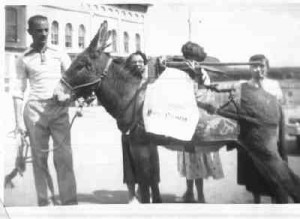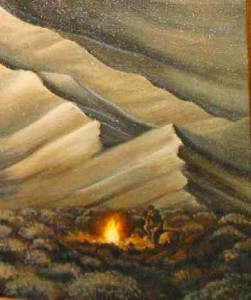Review by Lynda La Rocca
Utes – July 2004 – Colorado Central Magazine
Searching for Chipeta – The Story of a Ute and Her People
by Vickie Leigh Krudwig
Published in 2004 by Fulcrum Publishing
ISBN 1-55591-466-7
MAYBE IT’S JUST ME, but I cannot understand how a publisher can describe a book like Searching for Chipeta as “a nonfiction biography” when it reads like a novel — and a badly written one at that.
It takes more to create a “nonfiction biography” than combining actual people and places with a disjointed compendium of births, deaths, historical occurrences, government treaties, and words that I must assume are Ute without actually being told as much.
It’s true that Chipeta, wife of renowned 19th-century Ute leader Ouray, is an important figure in Colorado history. Together she and Ouray pursued a path that they thought would lead to peace, both for their people and with a greedy, invasive, and deceitful United States’ government. And even though they couldn’t stop the Anglo assault on Ute land and culture, their attempts were admirable.
In a publicity release accompanying the review copy, author Vickie Leigh Krudwig is quoted as saying that she wrote Searching for Chipeta so that “young readers [would] know the true story about one of the most remarkable women in Colorado history.”
But readers of all ages deserve more than heavy-handed and obviously invented scenes and fanciful speculation regarding Chipeta’s thoughts and emotions. Not one character in this 119-page volume emerges as a fully realized human being. And that is especially true of Chipeta, whose personality and motivations remain as murky and incomprehensible as the book’s jumbled chronology of events.
Krudwig may have anticipated such criticism when she wrote in her preface, “Although this book is based entirely on the actual history of Chipeta, there are many descriptions and emotions throughout the book that have been fabricated for the reader’s advantage.” I’ll go along with the use of the word “fabricated,” but I can’t agree that this tactic is to anyone’s “advantage.” This book is about the author as Chipeta, not about Chipeta herself.
It’s also troubling that the publisher, Fulcrum Publishing of Golden, can’t get its own blurbs straight. The previously mentioned release states that: “When she [Chipeta] was 16, she assumed the care of Ouray’s infant son, Paron, following the untimely death of Ouray’s first wife.” However, a summary on the publisher’s website reads: “When she was 16 Chipeta stepped in to care for her dead sister’s baby son, Paron, and her sister’s widower, Ouray.”
MAYBE THIS IS UNDERSTANDABLE, considering that the book itself several times describes Black Mare, Ouray’s first wife, as Chipeta’s “friend,” then says the two “were like sisters.” On the next page, Black Mare is Chipeta’s “childhood friend, her sister.” Then just two paragraphs later, Chipeta is helping “Ouray and Black Mare’s grieving family prepare her body for burial.” If the two actually were sisters, one would think that Chipeta would be referred to as a member of that grieving family.
Interestingly, in a review of another book about Chipeta, which appeared in the May issue of Colorado Central, Virginia McConnell Simmons points out “several misstatements, such as the assertion that … Ouray’s first wife, Black Mare, died, assumptions which cannot be verified.” Kind of makes you wonder what actually did happen to Black Mare.
And who was Paron? Did he even exist? I tried to find out quickly by doing a Google web search for “Paron son of Chief Ouray,” but came up with just one reference — to Krudwig’s book. Also perplexing is the fact that, although Chipeta had no biological children, Krudwig’s research involved “interviewing Chipeta’s great-great-grandson, O. Roland McCook Sr.” In the book, “McCook” is the surname of Chipeta’s “younger brother, John McCook.” Yet Krudwig never explains these bloodlines.
And since Chipeta was kidnapped as a baby and raised by the Utes, according to Fulcrum’s own publicity statements (plus another source I found which described Chipeta as a “Kiowa Apache” adopted by the Utes), any siblings would probably have been step-siblings.
As to how Chipeta could be a grandmother without first becoming a mother, page 100 of Krudwig’s book contains a single reference to “her [Chipeta’s] adopted wards.” Again, I had to search the Internet to discover, on the “Women of the West Museum: The LoDo Mural Project” web page, that Chipeta remarried after Ouray’s death and adopted four children. Is that how Chipeta managed to leave a “great-great-grandson” behind?
And is it merely coincidental that the Colorado territorial governor working diligently to remove the Utes from their ancestral lands during the late 1860s and early 1870s was also named McCook? We don’t know; Krudwig doesn’t tell us.
While I’m at it, what exactly are “lavender pascal flowers”? Does the author mean pasqueflowers?
And what happened to the final words in the last sentence on page 115?
Although this book contains some interesting historical detail and a handful of nice historical photographs, it would have benefited from a huge amount of editing and fact-checking — and from more “showing” and less “telling” of a story that warrants far better treatment.


